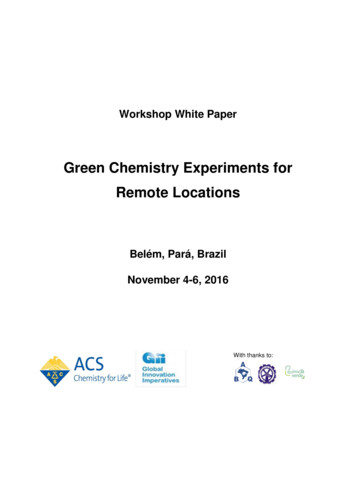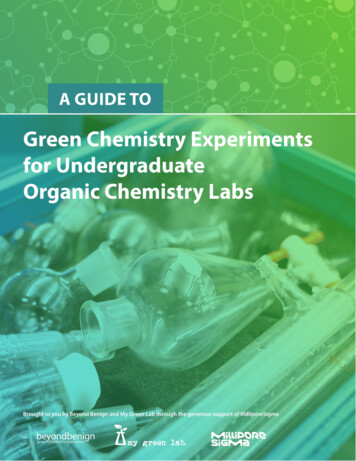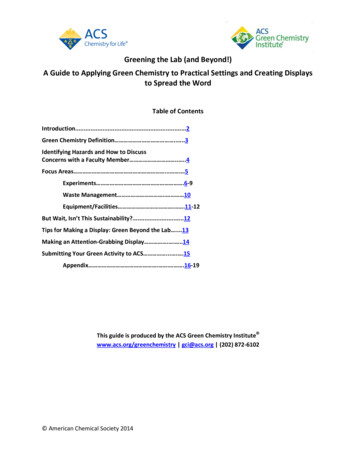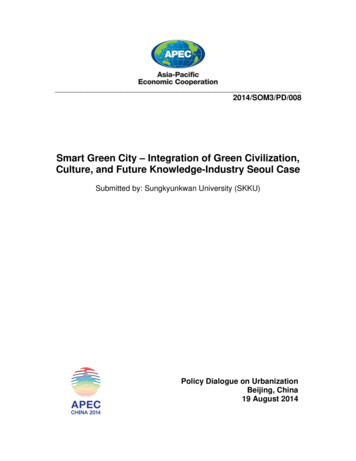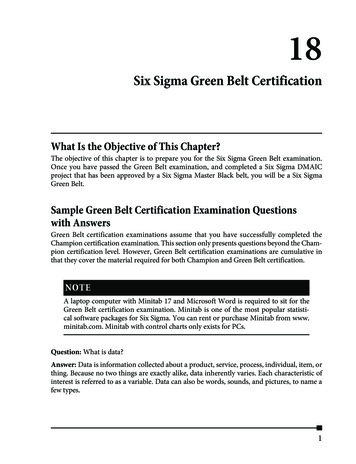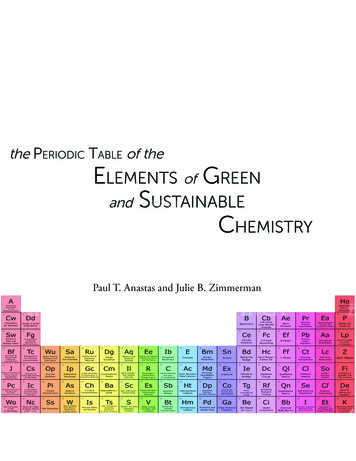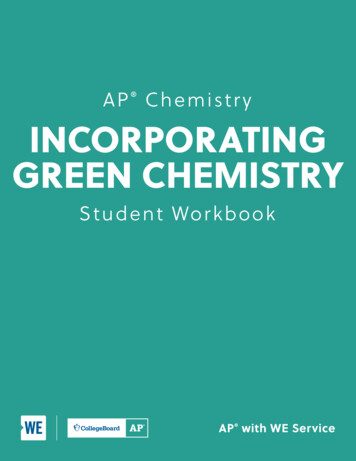
Transcription
A P Ch emis tr yINCORPORATINGGREEN CHEMISTRYS t u d e n t Wor kbookAP with WE Service
Table of ContentsGetting to Know the Topic.4It’s Easy Being GREEN.6Green Chemistry Awards: A Step Toward Solutions.7Redesign Challenge.8Problem Tree.10Sticky Situations.11Greener Clean.13Needs Assessment.14Solution Tree.15Reflect: Investigate and Learn.16Summarizing Your Investigation.17Working Independently.18Approaches to Taking Action Information Sheet.19Creating the Action Plan.20Five Action Planning Pitfalls Tip Sheet.21Reflect: Action Plan.22Student Log Sheet.233GREEN CHEMISTRY MODULE FOR AP CHEMISTRYAP WITH WE SERVICE
Getting to Know the TopicPollution: GloballyPollution occurs when harmful materials are introduced into the environment. The top five pollutants are ground-levelozone, particle pollution (or particulate matter), carbon monoxide, sulfur dioxide, and nitrogen dioxide. There are also otherdangerous contaminants such as soot, cigarette smoke, volatile organic compounds (VOCs), formaldehyde, asbestos, andmethane. These pollutants seep into our daily lives, impacting our planet and the humans and animals that live on it.Poor air quality is one of the biggest global killers, affecting more than 100 million people around the world. It’s beenconnected to higher rates of diseases such as cancer, heart disease, and asthma. Pollution also contributes to climate changeand is one factor in the frequency of heat waves and the occurrence of other extreme weather conditions. It contaminates ourwater supplies, depletes nutrients in the soil for agriculture, and harms forests and crops, among other effects.Fast Facts Every year, about 8 million tons of plastic waste escapes into the oceans from coastal nations. That’s the equivalentof setting five garbage bags full of trash on every foot of coastline around the world. 91% of the world’s population lives in places where air quality does not meet World Health Organization guideline limits. Pollution kills more than 1 million seabirds and 100 million mammals every year.Taking Action GloballyPollution is an issue that impacts everyone around the world, and there are a number of ways students can supportreducing pollution on a global level. Some ideas include: Research global organizations that are taking action against pollution and find one to support by volunteering orfundraising. Spread the word about pollution and climate change by setting up assemblies or speaking events. Attend an event with expert speakers to learn more about the issue.Another option is to support and fundraise for the WE Villages program. Students can support this program by visitingWE.org/we-schools/program/campaigns to get ideas and resources for taking action on global water issues.Humans have pumped enoughcarbon dioxide into the atmosphereover the past 150 years to raise itslevels higher than they have beenfor hundreds of thousands of years.4GREEN CHEMISTRY MODULE FOR AP CHEMISTRYAP WITH WE SERVICE
PLANGetting to Know the TopicPollution: LocallyIn the U.S., pollution is a major issue. Despite making up only 5 percent of the world’s population, Americans useup 25 percent of the world’s resources, contributing to poor air quality. The U.S. burns up nearly 25 percent of theworld’s coal, 26 percent of its oil and 27 percent of its natural gas. Burning these fuels releases contaminants into theatmosphere, affecting health, water supply, agriculture, and more. Approximately 88 percent of U.S. national parkshave high levels of air pollution that are directly impacting the environment, such as suppressing tree growth andaltering soil and water chemistry.Fast Facts Plastic pollution is an environmental issue that has increased exponentially, from 2.3 million tons in 1950 to448 million tons in 2015. Plastic production is expected to double by 2050. The Mississippi River carries an estimated 1.5 million metric tons of nitrogen pollution into the Gulf of Mexicoeach year, creating a “dead zone” about the size of New Jersey in the Gulf each summer. Approximately 40% of the lakes in America are too polluted for fishing, aquatic life, or swimming.Taking Action LocallyWithin the local community, there are many ways for students to take action, such as: Working with a local organization that is taking action against pollution and climate change through volunteering,fundraising, or raising awareness. Create a proposal or petition to change a local law or decision around pollution. Take part in the WE Go Green campaign and encourage behavioral changes that will positively impact the environment.With both their global and local actions, encourage students to be creative with the ideas they develop through theiraction plans.An estimated 82 million peoplenationwide live in counties with airpollution above U.S. standards.5GREEN CHEMISTRY MODULE FOR AP CHEMISTRYAP WITH WE SERVICE
NAME:TEAM MEMBERS:It’s Easy Being GREENAs you sort the cards, write the description in the box next to each principle.GREEN event WasteAtom EconomyLess Hazardous SynthesisDesign Benign ChemicalsBenign Solvents &AuxiliariesUse Renewable FeedstockReduce DerivativeCatalysisDesign for DegradationReal-time Analysis forPollution PreventionAccident PreventionDesign for EnergyEfficiency6GREEN CHEMISTRY MODULE FOR AP CHEMISTRYAP WITH WE SERVICE
INVESTIGATE AND LEARNNAME:TEAM MEMBERS:Green Chemistry Awards: A Step Toward SolutionsEach year the EPA (Environmental Protection Agency) recognizes the environmental and economic benefitsof developing and using novel Green Chemistry. These prestigious annual awards recognize chemicaltechnologies that incorporate the principles of Green Chemistry into chemical design, manufacture, anduse. Recent winners can be found at -challenge-winners.Research the recent award winners. Discuss their name, their contribution, and what principle of GreenChemistry their effort utilizes. Put this research into a chart so that information from other groups canbe added.AWARD WINNER NAME(S)7DESCRIPTION OF PROJECTGREEN CHEMISTRY MODULE FOR AP CHEMISTRYGREEN CHEMISTRY PRINCIPLEADDRESSEDAP WITH WE SERVICE
NAME:TEAM MEMBERS:Redesign ChallengeNot all reactions that could be safely performed in a chemistry classroom are environmentally friendly. You are to redesign acommon laboratory procedure to make it “greener.” Use the 12 principles of Green Chemistry to assist in your redesign. Usethe information in the MSDS provided, as well as your knowledge of efficient laboratory procedures.Purpose: To quantitatively analyze a precipitation reaction to determine the percent of carbonate in a compound.Materials available for use: Balance, beaker, graduated cylinder, deionized water, 50mL beaker, 250mL beaker, funnel,filter paper, stirring rod, sodium carbonate (Na2CO3), copper (II) carbonate (CuCO3), barium nitrate Ba(NO3)2, iron (III),chloride (FeCl3), zinc acetate (Zn(C2H3O2)2).MSDS for sodium carbonate: https://www.flinnsci.com/sds 716-sodium-carbonate/sds 716/MSDS for copper (II) carbonate: https://www.flinnsci.com/sds 280-copperii-carbonate/sds 280/MSDS for zinc acetate: https://www.flinnsci.com/sds 860-zinc-acetate/sds 860/MSDS for barium nitrate: https://www.flinnsci.com/sds 96-barium-nitrate/sds 96/MSDS for iron (III) chloride: https://www.flinnsci.com/sds 338-ironiii-chloride/sds 338/PROCEDUREREVISIONREASON/PRINCIPLE1. Weigh out 5.0g of silver nitrate into a250.0mL beaker. Record the mass of thebeaker empty. Record the mass of thebeaker and silver nitrate.2. Add 100.0mL of deionized water to thebeaker. Record the mass.3. Weigh out 10.0g of iron (III) chloride ina 250mL beaker. Record the mass of theempty beaker. Record the mass of thebeaker and iron (III) chloride.4. Add 100.0mL of deionized water to thebeaker. Record the mass.5. Add all of the silver nitrate solution tothe iron (III) chloride solution.6. Write the names of the members of yourgroup on a piece of filter paper. Fold thefilter paper to fit in a funnel. Take themass of the filter paper.8GREEN CHEMISTRY MODULE FOR AP CHEMISTRYAP WITH WE SERVICE
REVISIONREASON/PRINCIPLE7. Filter the precipitate product into a cleanErlenmeyer flask. Rinse both the beakerand precipitate several times with largeamounts of water.8. Allow the precipitate to dry overnight.If a drying oven is available, dry theprecipitate at low heat until dry.INVESTIGATE AND LEARNPROCEDURE9. Take the mass of the dry filter paper andprecipitate. Determine the amount ofproduct produced.10. Discard of all materials as appropriate.Analysis:1. Based on your results, calculate the percent of composition of carbonate in the reactant. Show all work includingunits and significant digits.2. Identify the limiting reactant in the reaction. Provide evidence of your answer.3. Determine the percent yield of your reaction.9GREEN CHEMISTRY MODULE FOR AP CHEMISTRYAP WITH WE SERVICE
NAME:TEAM MEMBERS:Problem TreeIn your Problem Tree graphic organizer, start by writing the problem in the trunk of the tree, and then look at the causesand effects of an issue. Keep digging to go deeper on the issue to find its supporting and root causes.Leaves/branches: EffectsThese are the results created by the problem. At first, this part of the issue appears easy to tackle, but when leavesand branches are trimmed, they grow back quickly. Consider the multi-layered effects, or “effects of effects,” that canarise when a problem goes unaddressed. Always ask: “Then what happens?”Ex. Contaminated waterwaysTrunk: ProblemThis is the key issue that is being studied. Because it is not as apparent as the leaves, the core problem itselfsometimes takes a little longer to identify.Ex. Harmful chemicals in fertilizersRoots: CausesThese are the situations or factors that have led to the problem. When exploring the root causes of a problem, askyourself “Why does this problem exist?” Dig deeper to consider the “causes of causes”—the multiple layers offactors that contribute to a problem.Ex. Growing need for increased agricultural productionProblem Tree Worksheet: Copyright 2018 WE. All rights reserved.10GREEN CHEMISTRY MODULE FOR AP CHEMISTRYAP WITH WE SERVICE
INVESTIGATE AND LEARNNAME:TEAM MEMBERS:Sticky SituationsMilk can be transformed into curds and whey by adding a mild acid such as acetic acid. After curds form and areseparated from the whey, the acid is neutralized with the sodium bicarbonate.The clumps of curds are comprised of casein, a protein found in milk. Casein proteins make up 3% of whole milk. Gluesmade from casein include products such as Elmer’s and other woodworking glues. Casein can also be molded or pouredinto forms to making a variety of plastic items such as combs, beads, buttons, and umbrella handles.In this lab you will make some “milk glue” and then compare it to more traditional glues to test its effectiveness.Materials: Skim milk, vinegar (acetic acid), baking soda (sodium bicarbonate), Erlenmeyer flask, thermometer, beaker,coffee filter, hot plate, stirring rod, refrigerator, plastic acetate, wooden craft sticks, paper or cardstock, white glue,rubber cementProcedure:1. Pour 100 mL of milk into an Erlenmeyer flask, measure and add 15 mL of acetic acid.2. Place the mixture on a hot plate, set the heat to 4, and heat. Stir gently with a glass stirring rod. Observe themixture carefully, and stop when you see solid curds floating in the flask. Do not overheat mixture; the proteinwill denature (unravel), and your glue won’t be sticky.3. Filter the mixture, using a coffee filter, into a beaker. The curds should remain in the coffee filter, whilethe filtrate (liquid) passes into the beaker. Gently squeeze the coffee filter to press some of the excess filtratethrough. Discard the filtrate in the sink; this contains the whey (sugars).4. Scrape the curds from the coffee filter into a small plastic cup.5. Add ½ teaspoon of baking soda (NaHCO3) to the cup and stir with a wooden stick. Slowly add several drops ofwater, stirring continually until the consistency of white glue is obtained.6. Paint a uniform and consistently sized circle of each adhesive between two pieces of each material (paper, wood,plastic acetate), gluing them together. Make two sets, one that will go into the refrigerator and one that will stay atroom temperature. Record the temperature of the refrigerator and the room temperature in the data table.7.Mark each sample with a relevant identification. Set the test samples aside to cure (convert from liquid to solid) atroom temperature, and put the other test samples in the refrigerator.8. Record the time at which all of the samples have begun to cure in the data table.9. Allow to sit until next class period (at least 24 hours).10. Have the group appoint a person as the official “force applier.” Using the refrigerated samples first, have thatperson slowly separate each sample by gradually applying a pulling force, trying to separate the materials. Byobserving their “force applier,” the group should rate the strength of the intermolecular forces, using a scale of 1–5,in which 1 is the weakest ability to hold the material together, and 5 is the strongest. Record all information in datatable.11GREEN CHEMISTRY MODULE FOR AP CHEMISTRYAP WITH WE SERVICE
Analysis:1. Write a CER (Claim, Evidence, and Reasoning) statement about the effectiveness of each adhesive. Be sure toinclude principles of intermolecular forces, adhesion, and cohesion in your reasoning.2. Explain which of the 12 Principles of Green Chemistry were demonstrated in your manufacture of “greener” glue.12GREEN CHEMISTRY MODULE FOR AP CHEMISTRYAP WITH WE SERVICE
INVESTIGATE AND LEARNNAME:TEAM MEMBERS:Greener CleanYou are going to formulate a green cleaner using the simulation found graduate-graduateRecord your setting and results in the table below.TRIAL #PARAMETER 1PARAMETER 2PARAMETER 3SUCCESS (YES/NO)EXPLANATIONAnalyze1. What parameters did you need to consider when making your cleaner, and why?2. Did you succeed the first time? What prevented success?3. What principles of Green Chemistry were illustrated in this formulation activity?13GREEN CHEMISTRY MODULE FOR AP CHEMISTRYAP WITH WE SERVICE
NAME:TEAM MEMBERS:Needs AssessmentThe following series of questions helps you to analyze and identify ongoing areas of need within organizationsaddressing your issue.1. Identify 3-5 organizations working on issues related to the issue your team is working on.2. What does each organization do well in response to the issue and/or related issues?3. What could each organization do better in its response?4. What areas of need related to access to your issue have you learned about that each organization is NOT addressing?5. Considering all 3-5 organizations, where are there ongoing needs that are not being adequately addressed?6. Considering all 3-5 organizations, where are there ongoing needs that are being addressed successfully, and towhich you can add further efforts to support the issue?14GREEN CHEMISTRY MODULE FOR AP CHEMISTRYAP WITH WE SERVICE
INVESTIGATE AND LEARNNAME:TEAM MEMBERS:Solution TreeIn your Solution Tree graphic organizer, start by rewriting the problem from your Problem Tree, and reframing it as a goalat the trunk of the tree. Then consider the different solutions (the roots) and possible outcomes of the solutions (the branches).Leaves/branches: OutcomesThese are the results created by the solution. Results may appear as straightforward as having achieved goals,but when you consider the ripple effects and outcomes of sustainable results, the impact is far-reaching and longlasting. Always ask: “Then what happens?”Trunk: ProblemTrunk: GoalRoots: SolutionsThese are the actions needed to solve the problem and achieve the goal stated at the center of the Solution Tree. Whenexploring solutions, ask yourself “How will this solve the problem?” Dig deeper to think holistically, so that you arelooking beyond the short-term and addressing not only the symptoms of the problem but the root causes as well.Solution Tree Worksheet: Copyright 2018 WE. All rights reserved.15GREEN CHEMISTRY MODULE FOR AP CHEMISTRYAP WITH WE SERVICE
NAME:TEAM MEMBERS:Reflect: Investigate and LearnNow that you have investigated problems and potential solutions associated with implementation of Green ChemistryPrinciples, think back over what you have learned: How can what you are learning in your AP Chemistry classsupport your solutions? Is the company/industry doing all they can to implement Green Chemistry?Record your thoughts on the lines below. If you run out of room on this page, use additional paper to write a lengthierresponse. As you write, think about the following questions to help shape your reflection. What are the social impacts of Green Chemistry? As you investigated different companies addressing Green Chemistry principles, what did you feel these programsdo well, and what did you feel they could do better? Does the company have a Sustainability Policy? Based on what you learned about your local and global issue and the actions others are already taking, what are fiveareas of need that you could address? What attracts you to these areas?What are some actions that you could take to address this issue?What excites you about these actions and the impact you can have?How can what you are learning in your AP Chemistry class support solutions that improve Green Chemistryimplementation?16GREEN CHEMISTRY MODULE FOR AP CHEMISTRYAP WITH WE SERVICE
INVESTIGATE AND LEARNNAME:TEAM MEMBERS:Summarizing Your InvestigationSummarize what you have learned from your investigation. Your work may be supported by multimedia or printmaterials that synthesize and analyze the topic and issue on local and global levels.When summarizing your investigation, keep the following in mind:17 What are the key takeaways from your investigation of the Green Chemistry? How are the problems you investigated similar at local and global levels? How are they different? How are the solutions you investigated similar at local and global levels? How are they different? Why may your investigation be important to other AP Chemistry students?GREEN CHEMISTRY MODULE FOR AP CHEMISTRYAP WITH WE SERVICE
NAME:TEAM MEMBERS:Working IndependentlyFree Response Question 1Mass of KI tablet0.425Mass of thoroughly dried filter paper1.462 gMass of filter paper precipitate after first drying1.775 gMass of filter paper precipitate after second drying1.699 gMass of filter paper precipitate after third drying1.698 gA student is given the task of determining the I-content of tablets that contain KI and an inert, water-soluble sugaras a filler. A tablet is dissolved in 50.0 mL of distilled water, and an excess of 0.20 M Pb(NO3)2(aq) is added to thesolution. A yellow precipitate forms, which is then filtered, washed, and dried. The data from the experiment areshown in the table above.a. For the chemical reaction that occurs when the precipitate forms, write a balanced, net-ionic equation for the reaction,and explain why the reaction is best represented by a net ionic equation.b. Explain the purpose of drying and weighing the filter paper with the precipitate three times.c. In the filtrate solution, is [K ] greater than, less than, or equal to [NO3-]? Justify your answer.d. Calculate the number of moles of precipitate that is produced in the experiment.e. Calculate the mass percent of I- in the tablet.f. In another trial, the student dissolves a tablet in 55.0 mL of water instead of 50.0 mL of water. Predict whether theexperimentally determined mass percent of I- will be greater than, less than, or equal to the amount calculated inpart (e). Justify your answer.g. A student in another lab also wants to determine the I- content of a KI tablet but does not have access to Pb(NO3)2.However, the student does have access to 0.20 M AgNO3, which reacts with I-(aq) to produce AgI(s). The value ofKsp for AgI is 8.5 x 10-17.i. Will the substitution of AgNO3 for Pb(NO3)2 result in the precipitation of the I- ion from solution?Justify your answer.ii. The student only has access to one KI tablet and a balance that can measure to the nearest 0.01 g. Will the studentbe able to determine the mass of AgI produced to three significant figures? Justify your answer.18GREEN CHEMISTRY MODULE FOR AP CHEMISTRYAP WITH WE SERVICE
ACTION PLANApproaches to Taking ActionInformation SheetDIRECT SERVICEWHAT IS IT?Personally engaging with and providing hands-on service to those in need (usually in conjunction with anorganization).EXAMPLEGOALBy the end of the semester, we will support a local food bank and shelter by packing and serving food topeople in the community. We will also visit our neighboring elementary school and teach a lesson on foodinsecurity in our community.ACTIONS Reach out to local shelters and foodbanks to arrange a day for the class tovisit and provide hands-on support Once a date has been decided, make surestudents all have permission to travel tothe food bank (if during school hours) Connect with teachers/administrationat local elementary school and arrangeto visit a classroom to teach a lesson toyoung students on food insecurity Create and print worksheets to use withyounger studentsINDIRECT SERVICEWHAT IS IT?Channeling resources to the needs of a community—locally, nationally, or internationally.EXAMPLEGOALBy the end of the year, we will create a storage and donation system for local families in need, where they canaccess furniture and other household items. We will develop a system for donations, pick-ups, and inventory.ACTIONS Conduct research into which items aremost needed by community members(e.g., bed frames, dining tables,household goods, etc.) Reach out to local businesses to try to geta storage space donated Connect with school social workers/administration to gain their support Put up flyers around school and inthe community, asking for donations(list specific items needed), includinginstructions on how/where to donate Develop an online database for trackingdonations and pick-ups, and maintaininginventory Share pick-up information with localshelters, churches, community centers,etc. Share the donation system with schoolsocial workers, so that they can maintainthe project in future yearsADVOCACYWHAT ISIT?Educating others about an issue to increase visibility and following up with an action that focuses onenacting change. Actions around advocacy often look like raising awareness, but without a strong call toaction within the initiative as a whole. Educating others is not considered service in and of itself.EXAMPLEGOALThrough an informative art piece, we will educate our school community about the waste created by singleuse plastic water bottles, and the impact they have on the environment. Then, we will sell reusable waterbottles at school, and the proceeds from the sale will go toward clean water projects in developing countries.ACTIONS Research the impact of single-use plasticwater bottles around the school and in thelocal community Plan out and create a 3D sculpture thatincorporates informative text on the issueof single-use plastics Seek permission from schooladministration to display the piece in acommon area of the school Design and order water bottles to sellat school Research and select an internationalorganization that focuses on clean waterprojects Organize a selling schedule for thewater bottles, donate profitsApproaches to Taking Action Information Sheet: Copyright 2018 WE. All rights reserved.19GREEN CHEMISTRY MODULE FOR AP CHEMISTRYAP WITH WE SERVICE
NAME:TEAM MEMBERS:Creating the Action PlanThis outline serves as a basic template for your action plan. Use additional space and resources to help you buildout each part with the right amount of detail and flow to ensure you have the strongest action plan that you andyour team can implement with ease. Remember, this is your road map for your service project!TEAM GOAL:MEASURES OF SUCCESS:Required Network and ResourcesIn order to complete this goal, our team will need to develop the following network and access the following resources:NETWORK:RESOURCES:ROLES AND RESPONSIBILITIESEach team member will take on the following roles and associated responsibilities:TIMELINEOur team will use the following timeline to complete tasks and successfully carry outthe action to meet our goal(s):20GREEN CHEMISTRY MODULE FOR AP CHEMISTRYAP WITH WE SERVICE
ACTION PLANNAME:TEAM MEMBERS:Five Action Planning Pitfalls Tip SheetOnce your team has completed the major components of your action plan (creating your teams and setting goals, timeline,and network), review the five action planning pitfalls provided below to ensure these have been avoided. Review yourplans—individually first, then together as a team. After the review, rework your action plans, if necessary.1. Setting an unclear goal4. Not asking for helpThe first and most important part of any action planDo not be afraid to ask for help. When a network isis defining the goal, or what you want to achieve. Itcreated, bigger goals can be achieved faster. Reach outshould be clear and easy to understand, for example,to friends, parents, and mentors. People generally enjoy“We want to collect 500 cans of food,” or “We wanthelping, especially if it is for a worthy cause.200 people to learn about WE Villages.” If the goal isnot clearly defined, proper planning will be difficult ifnot impossible. As a best practice, have a peer fromanother team review your goal to ensure it is as clearas you hope.2. Planning unrealistic actions5. Not learning from mistakes and givingup too quicklyWe all make mistakes—it is normal and healthy.Mistakes allow us an opportunity to learn and grow. So,learn from the mistakes. Ask, “Why did this happen?”and “How can I avoid this problem next time?” ActivelyAfter the goal is set, begin planning the actionsthink about the mistakes and how it will be betternecessary to achieve it. It is important that the stepsthe second time around. If something does not go asmake sense and are achievable. Do not plan unrealisticplanned, do not stop!actions, such as working at times that will interferewith schoolwork, overestimating how many peoplecan help out, or planning to go to places that would bedifficult for you to reach. Consider each team member’sschool and community schedule, such as work andextracurricular activities. Before planning an action,ask yourself, “Is this action realistic?”3. Rushing the processDo not be too hasty in planning actions. While you maybe excited to start, proper planning takes time. Thebetter the planning and organization, the more successyou will achieve. Even if it means slowing down tofigure out details, do not rush and leave out importantsteps.21GREEN CHEMISTRY MODULE FOR AP CHEMISTRYAP WITH WE SERVICE
NAME:TEAM MEMBERS:Reflect: Action PlanYour team now has a plan for taking action globallyand locally. Think back over what you have learned:What problems associated with access to clean waterdoes your team’s action plan address? How does yourindividual role in the plan support your team’s action?22GREEN CHEMISTRY MODULE FOR AP CHEMISTRYAs you write, think about the following questions tohelp shape your reflection. Begin at the “Start Here”bubble and go clockwise to record your thoughts on thelines b
3 GREEN CHEMISTRY MODULE FOR AP CHEMISTRY AP WIT WE SERICE. Getting to Know the Topic4. It s Easy Being GREEN6. Green Chemistry Awards: A Step Toward Solutions7. Redesign Challenge8. Problem Tree10. Sticky Situations11. Greener Clean13. Needs Assessment14. Solution Tre

